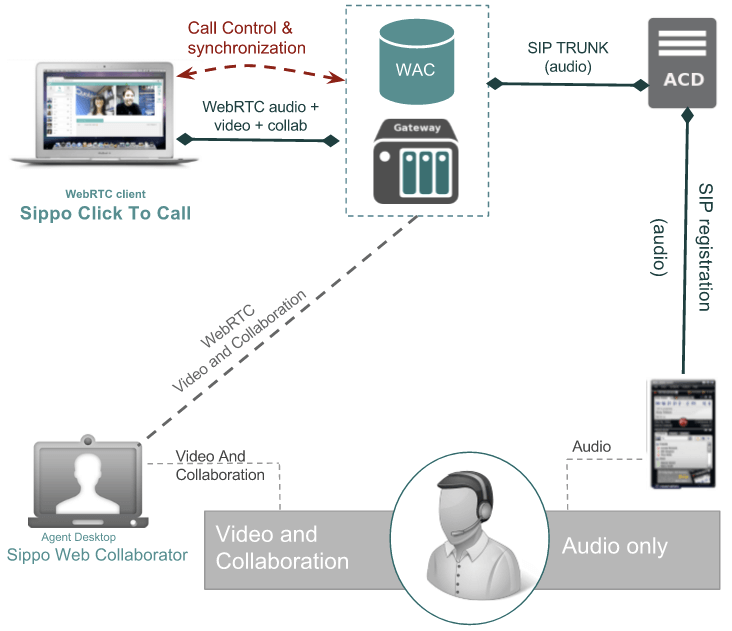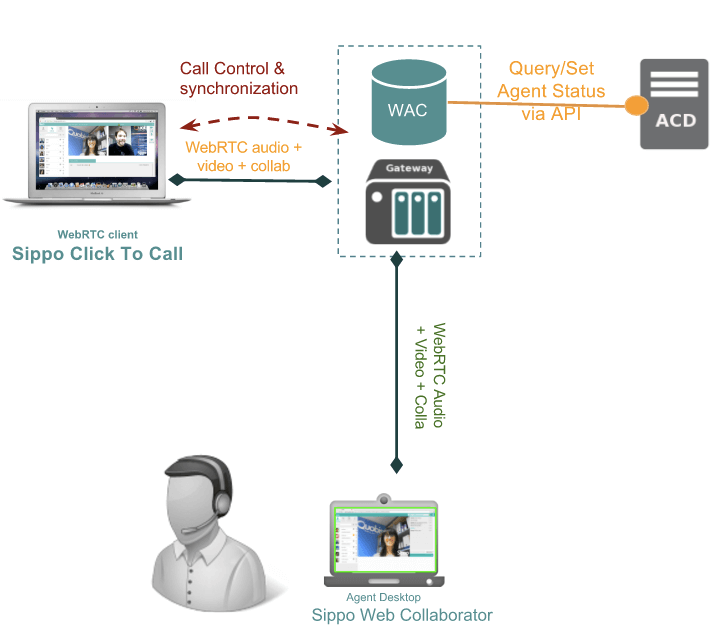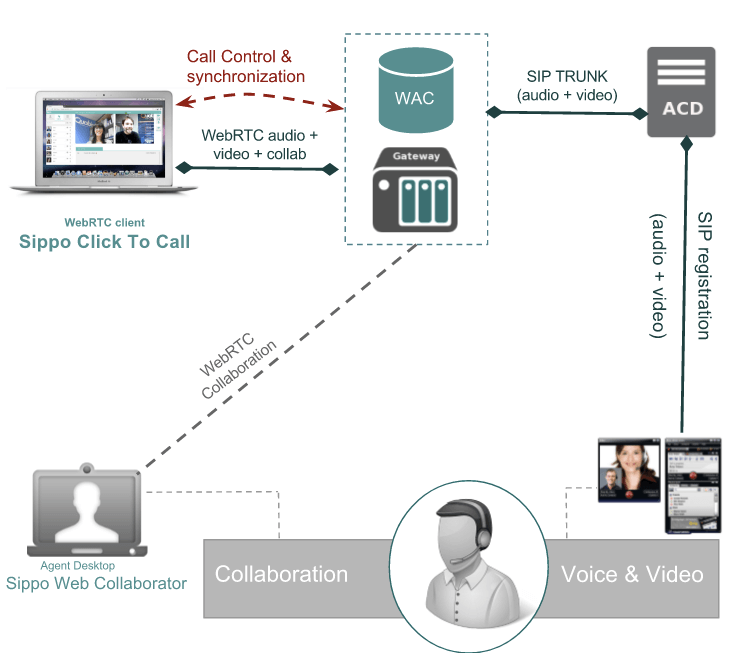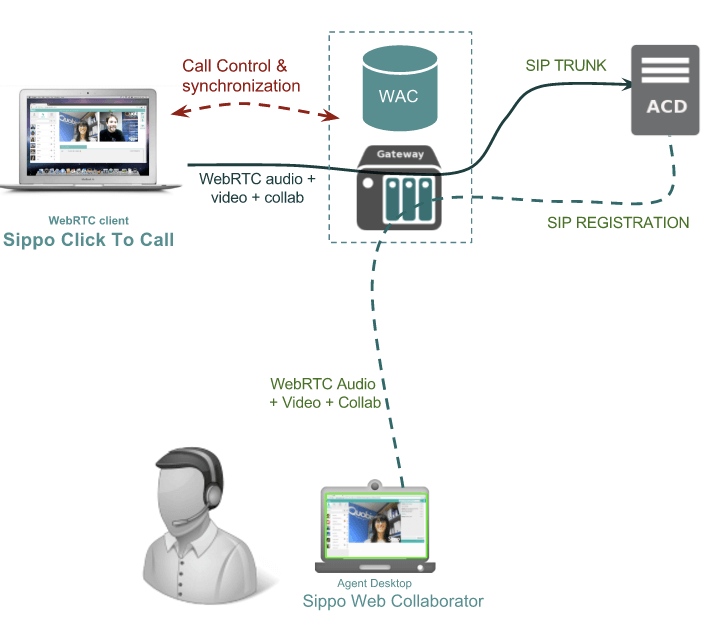Integration of Sippo Click to Call into call centers
2 October 2016
Partners and end customer ask very often about the different possibilities they have to integration WebRTC-based click to call buttons with their existing architecture. Most of them are willing to use the current platforms in order optimise agents time and existing metrics. And this is possible the WebRTC call is adapted to SIP so the legacy ACD can route the voice call to an available agent. This approach has the following benefits:
 As mentioned, calls can be tracked on the legacy PBX as any other call and this is a easy way to add video to a legacy contact center platform that is only supporting voice.
Another possibility is the integration via APIs, in case the existing ACD is exposing methods to manage agents.
If the contact-center PBX is able to expose an API to query and set the agent status the integration is possible keeping the voice in the browser of the agent:
As mentioned, calls can be tracked on the legacy PBX as any other call and this is a easy way to add video to a legacy contact center platform that is only supporting voice.
Another possibility is the integration via APIs, in case the existing ACD is exposing methods to manage agents.
If the contact-center PBX is able to expose an API to query and set the agent status the integration is possible keeping the voice in the browser of the agent:
 In this case, no capacity increase or new licenses are required on the legacy PBX and agents can be shared between this service and existing ones (blended).
We've found some scenarios where the contact center platform supports VP8 codec for video, so WebRTC is interesting for them as this represents a way to take advantage of the existing features of the platform (Sippo Click to Call enables end customers with voice/video capabilities, bringing new calls to the call center). The following scenario based on Sippo can be deployed:
In this case, no capacity increase or new licenses are required on the legacy PBX and agents can be shared between this service and existing ones (blended).
We've found some scenarios where the contact center platform supports VP8 codec for video, so WebRTC is interesting for them as this represents a way to take advantage of the existing features of the platform (Sippo Click to Call enables end customers with voice/video capabilities, bringing new calls to the call center). The following scenario based on Sippo can be deployed:
 Despite video calls are managed from the PBX as any other call, Sippo Web Collaborator can provide some advanced collaboration tools (screen sharing, shared forms, selfie, file transfer, etc), so is also possible to use this solution in these customers.
There is a final scenario where the contact center platform may support VP8 video and also SIP registration for agents.< In this case we can leverage Sippo Web Collaborator as the contact center tool:
Despite video calls are managed from the PBX as any other call, Sippo Web Collaborator can provide some advanced collaboration tools (screen sharing, shared forms, selfie, file transfer, etc), so is also possible to use this solution in these customers.
There is a final scenario where the contact center platform may support VP8 video and also SIP registration for agents.< In this case we can leverage Sippo Web Collaborator as the contact center tool:
- Agents can answer calls of other services, WebRTC-based calls are not more than a new channel. No dedicated agents for WebRTC
- ACD, route policies, statistics and KPI are preserved !!
- Reduced cost, no adaptation problems.
- A SIP trunk is setup between Sippo and the PBX for voice only
- Voice is sent from Sippo to the PBX, that routes them to an available agent
- Video is sent from Sippo to the agent’s browser
- Agents use PBXs softphone for voice only, and Sippo WebCollaborator for video and collaboration
- Call correlation is done via and ID sent on the SIP headers and/or shown to the customer
 As mentioned, calls can be tracked on the legacy PBX as any other call and this is a easy way to add video to a legacy contact center platform that is only supporting voice.
Another possibility is the integration via APIs, in case the existing ACD is exposing methods to manage agents.
If the contact-center PBX is able to expose an API to query and set the agent status the integration is possible keeping the voice in the browser of the agent:
As mentioned, calls can be tracked on the legacy PBX as any other call and this is a easy way to add video to a legacy contact center platform that is only supporting voice.
Another possibility is the integration via APIs, in case the existing ACD is exposing methods to manage agents.
If the contact-center PBX is able to expose an API to query and set the agent status the integration is possible keeping the voice in the browser of the agent:
- Media flows from the customer browser to the agent browser
- PBX is only used for querying agent’s availability, without SIP integration
- Agents use Sippo Web Collaborator for audio, video and collaboration.
 In this case, no capacity increase or new licenses are required on the legacy PBX and agents can be shared between this service and existing ones (blended).
We've found some scenarios where the contact center platform supports VP8 codec for video, so WebRTC is interesting for them as this represents a way to take advantage of the existing features of the platform (Sippo Click to Call enables end customers with voice/video capabilities, bringing new calls to the call center). The following scenario based on Sippo can be deployed:
In this case, no capacity increase or new licenses are required on the legacy PBX and agents can be shared between this service and existing ones (blended).
We've found some scenarios where the contact center platform supports VP8 codec for video, so WebRTC is interesting for them as this represents a way to take advantage of the existing features of the platform (Sippo Click to Call enables end customers with voice/video capabilities, bringing new calls to the call center). The following scenario based on Sippo can be deployed:
- A SIP trunk is setup between Sippo and the PBX for voice and video
- Calls are sent from Sippo to the PBX, that routes them to an available agent
- Agents use their existing video softphone for audio and video, while using Sippo for collaboration
 Despite video calls are managed from the PBX as any other call, Sippo Web Collaborator can provide some advanced collaboration tools (screen sharing, shared forms, selfie, file transfer, etc), so is also possible to use this solution in these customers.
There is a final scenario where the contact center platform may support VP8 video and also SIP registration for agents.< In this case we can leverage Sippo Web Collaborator as the contact center tool:
Despite video calls are managed from the PBX as any other call, Sippo Web Collaborator can provide some advanced collaboration tools (screen sharing, shared forms, selfie, file transfer, etc), so is also possible to use this solution in these customers.
There is a final scenario where the contact center platform may support VP8 video and also SIP registration for agents.< In this case we can leverage Sippo Web Collaborator as the contact center tool:
- A SIP trunk is setup between Sippo and the PBX for voice and video
- Agents SIP-register into the PBX
- Calls are sent from Sippo to the PBX, that routes them to an available agent
- Agents use Sippo Web Collaborator for voice, video and collaboration
- Call correlation is done via and ID sent on the SIP headers and/or shown to the customer
Quobis certified through Nokia’s Telco Cloud Partner Certification program
Quobis has been certified through the Nokia Telco Cloud Partner Certification program,Nokia’s partner solution certification process that aims to reduce [...]




